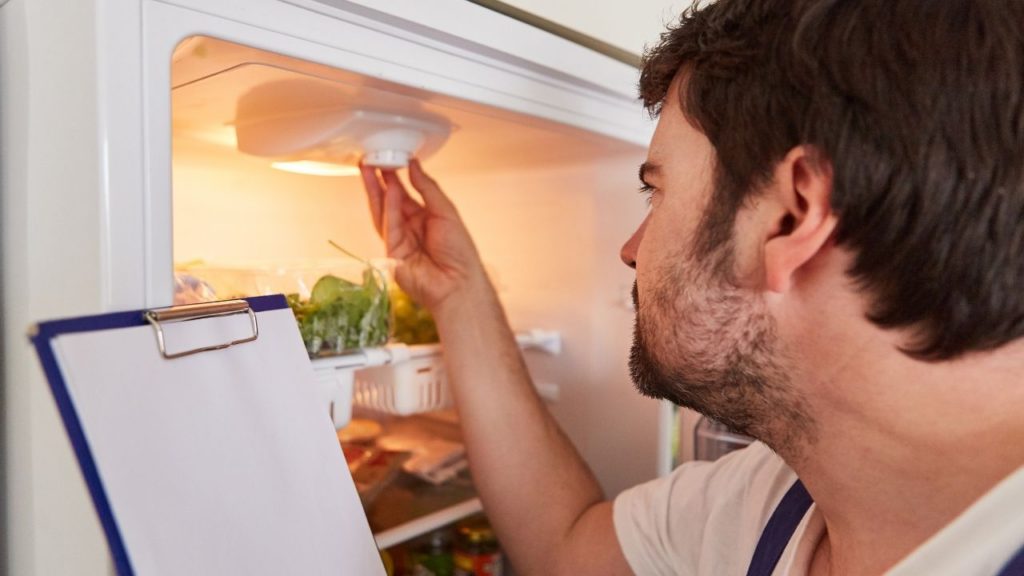Have you ever tip-toed to the kitchen in the middle of the night in search of a midnight snack while trying not to get caught by other members of the household? It is unfortunate when you attempt to sneak some snacks to munch on and are met with no light in the fridge, which makes it difficult to rummage through the items. Don’t worry, though. Replacing the refrigerator light bulb is easy!

Table of Contents
Why the Refrigerator Light Bulb Is Not Working
This may come as a surprise, but many people mistake a power interruption for their lights not working. However, there are some things to consider before coming to any conclusion.
1. Disconnected Power Cord
Checking if the power cord is connected is the first way to test any theories. For example, there are instances when the fridge’s cord is loose and not connected to the power outlet properly, which limits the electricity supply, and thus, the bulb doesn’t light up.
2. Circuit Breaker Overload
A circuit breaker can trip due to an overload. This can also happen when there is a short circuit. An easy solution to this is to reset the circuit breaker and set things back to normal. Also, try not to overload the breaker with multiple heavy-duty appliances at once.
3. Sudden Power Outage
Power outages can cause light bulbs to fail. Check whether other bulbs in the house are working or not before making any assumptions.
4. Faulty Electrical Outlet
A malfunctioning electrical outlet can cause the fridge bulb to fail and stop working. This can also cause the fridge to stop running entirely.
5. Damaged Power Cord
Damaged power cords intervene in electrical flow and can only be fixed with professional help from an electrician. It is advised to set up a consultation with them if this occurs.
6. Dirty Bulb Socket
Check the bulb’s socket to see whether it works or not. There are many visual indicators, such as damaged wires, discolored terminals, or a fractured light socket. These issues cause the bulb to not emit light.
7. Malfunctioning Fridge Door
Check whether the fridge door is functional, as the door is the source of the voltage passing to the bulb in the fridge. If all things mentioned above are not the issue, then the fridge door may be faulty. You can manually remove the door switch from inside the fridge and then checked against a meter.
How to Choose a Replacement Fridge Bulb
If you run through the above checklist and find that none of those seem to be the cause, then your bulb is faulty and needs a replacement. If the fridge works smoothly and the bulb still isn’t emitting light, then the bulb is the issue’s root cause. The solution is simple. Get refrigerator light bulbs and replace the old ones.
LED vs. Incandescent
An LED (light-emitting diode) light uses a semiconductor powered by electricity. Many households prefer them because they emit bright light without consuming too much electricity. Moreover, they last longer and have longer lifespans. On the other hand, incandescent light bulbs emit light using the heat of a filament powered by electricity. Therefore, people who prefer to use LEDs essentially have more benefits.
Brightness
The average brightness of fridge incandescent light bulbs emits around 300-600 lumens at 40 watts. At the same time, LED bulbs use fewer watts for the same level of luminousness. This means an LED bulb has better brightness.
Two Types of Light Bulbs
You can find bulbs with a clear coating or a frosted coating. If you don’t know which one to pick, you should always go for frosted-coated LED bulbs because they disperse the light softly on the eyes, not irritating them.
Pear Bulbs
You will find pear-shaped bulbs online or in retail stores. Many electronic appliances like the refrigerator use this kind of bulb. Don’t worry about finding the right size since fridges are built for adjusting size A15 bulbs or called “standard” size. LED bulbs usually come in extended coiled frames. Experts do not recommend CFL bulbs despite their advantage of being fluorescent.
The best thing to do is to always match your fridge’s old bulb specs to the new light you’ll get. Most of the time, they have the size and wattage on the surface. If not, you can always read the manual again or get in touch with the fridge manufacturer for light bulb recommendations. Then, you can browse through the bulbs available in the nearest hardware store to make an informed decision that matches the requirements of your fridge.
CFL Bulbs
You shouldn’t use CFL bulbs in the refrigerator. The low temperatures in the fridge can damage the bulb by cracking it. Not only that, but CFL bulbs have mercury in them, which is concerning since it can poison the items kept in the fridge. Consuming such foods would lead to food poisoning.
How to Replace the Refrigerator Light Bulb
- Turn off all supplies of electricity. The simplest way to do so is to switch off the power outlet. This will keep you safe and reduce the chances of electrocution. As a precaution, you should wear rubber sandals to avoid electrical shocks.
- Detach the lamp cover by dismantling it with a screwdriver. Not all machines have a lamp cover over the bulb, but follow this step if your appliance does.
- The final step is to replace the old bulb with a new well-functioning one that matches the specifications of your fridge. Once it is in place, you should then reverse the step and screw the lamp cover back onto the fridge to protect the bulb using a screwdriver.
So, there you go! This article has served as a guide on how to change a bulb in your fridge easily. Hopefully, this helps you to make a quick fix without any trouble.
